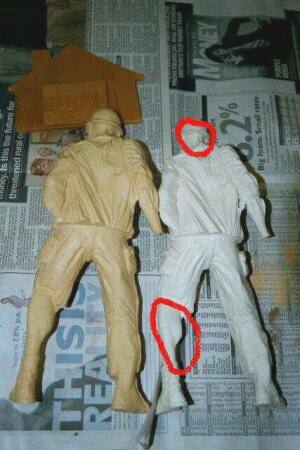|
RECAST FAQ WHAT IS A GARAGE KIT? This goes back to the roots of the figure modeling hobby as we know it today. In my mindís eye, the story goes something like this: Itís the 80ís. Some guys who grew up building Auroraís classic figure kits in styrene looked around and decided that they wanted to see some of their favorite characters from movies, comics, and the like made into model kits. They picked up some clay and began to sculpt their own. They took the sculpts and made silicone molds into which they would pour two-part resin plastic to produce kits they could sell to or trade with fellow enthusiasts. These cottage industry productions were carried out in the basements and garages of these brave pioneers. Hence the term "garage kit." As the years passed, the hobby grew. It already existed in its own form in Japan. Japanese and American producers became more and more savvy and professional and the hobby emerged from a solely garage-based set of ventures and sprouted some larger operations. These companies had names like Billiken, Horizon, Screamin, and Geometric. Many of the early companies invested in metal molds and cast their kits in vinyl rather than resin. But the whole time, the garage operations continued and the name "garage kit" stuck even when people were referring to kits produced by these larger operations. Today, these big companies arenít around any more, and few new vinyl kits are produced. But the hobby is far from dead. We have gone back to the future in a way Ė back to smaller resin operations. However, todayís sculptors and casters, thanks to the natural evolution of the hobby, are much more sophisticated and use techniques the pioneers never dreamed of to produce outrageously accurate and detailed kits that are beautifully cast and a joy to build. You should appreciate that most of these operations, while capable of making very professional products, are operating on a shoe string. With all of the costs of production, these are usually break even type ventures where any profits simply go into producing the next new offering. In short, these operations exist because these small producers are fellow enthusiasts and love of the hobby; no oneís getting rich here and these are essentially individuals (as opposed to say, big nameless corporations). While there are many good websites to check out relating to this hobby, if you want to get a quick overview of whatís going on right now in terms of new kits produced in the last few years, a good place to start is: Buc Wheatís Modeling World at: http://home.cshore.com/bucwheat/ WHAT IS A "RECAST"? Itís an unauthorized copy of a kit. The copies are usually made of resin, but some well-financed re-casters (especially in Asia) are capable of making vinyl copies. In simple terms, recasting happens when unscrupulous individuals obtain an original of a kit and use it as a master to make their own mold and produce cheap knock-offs. These copies are referred to as "recasts." Recasts are ALWAYS inferior to the original kit. Just as a photocopy of photocopy is worse than a photocopy of an original, a recast of a kit is necessarily worse than a casting that comes from a mold made using the original prototype. Detail and crispness is always lost. Add to that the fact that re-casters donít really care about the modeler, but only making a quick buck, and therefore do things like: use cheap materials (e.g., brittle, bad-smelling resin); do slip shod quickly casting jobs (e.g., resulting in offset seams, pin holes, and uncured spots); use molds that are worn out (silicone molds start to break down after a certain number of castings from the heat generated as the resin sets); donít bother to produce unusual parts (e.g., white metal or vacuform plastic accessories); and donít bother to produce box art or even include a box with the kit. What does the re-caster care if the modeler gets so frustrated building the recast that he decides the original kit producer makes crap products and vows never to buy another kit made by that producer, the re-caster will just steal someone elseís work. Some of the worst quality recasts of this sort are those that one cannot help but run into on E-Bay: those being sold by re-casters in Thailand, Singapore, and other places in Asia. Pictured below is a recast placed next to an original; note the huge differences in quality; the red circles indicate major casting flaws in recast (pictures courtesy of Mark Atherton)
There is a species of re-casters who will actually go the extra mile in a more sophisticated effort to fool you. That is, they will actually work hard at making a good mold and casting and go to the expense of copying the extras like box art and instructions. These re-casters however, are usually trying to pass the kit off as original and hence offer little discount off the producerís price. These re-casters are particularly insidious and hard to identify, but producers are presently working on ways to help buyers do just that using various indicators of authenticity (e.g., special stickers, certificates of authenticity, etc.). |
||||





